Form NHTSA Form 1674 NHTSA Form 1674 MMUCC Survey A
Model Minimum Uniform Crash Criteria
NHTSA Form 1674_MMUCC Survey A Final
Survey of Law Enforcement Officers
OMB: 2127-0759
OMB Control No. 2127-xxxx
Expiration Date xx/xx/xxxx
MMUCC Evaluation Survey A
Introduction
The National Highway Traffic Safety Administration (NHTSA) is seeking feedback from law enforcement officers on the feasibility of collecting the crash data described in the Model Minimum Uniform Crash Criteria (MMUCC) Guideline, fifth edition (DOT HS 812 433, July 2017). As a law enforcement officer who responds to crashes and writes crash reports, your participation is important to help NHTSA identify crash data elements and concepts that can be accurately collected and others that are flawed and require revision or elimination. All responses are anonymous and will be analyzed in the aggregate. The information you provide will inform the content of the next edition of MMUCC. We estimate that it will take you approximately 60 minutes to complete the survey. NHTSA will publish a summary of this research in an appendix to the next edition of MMUCC in 2024.
This collection of information is voluntary and will be used to identify problematic crash data elements, and concepts in MMUCC. A federal agency may not conduct or sponsor, and a person is not required to respond to, nor shall a person be subject to a penalty for failure to comply with, a collection of information subject to the requirements of the Paperwork Reduction Act unless that collection of information displays a current valid OMB Control Number. The OMB Control Number for this information collection is XXXXX. Public reporting for this collection of information is estimated to be approximately 60 minutes per response, including the time for reviewing instructions, and completing and reviewing the collection of information. All responses to this collection of information are voluntary. Send comments regarding this burden estimate or any other aspect of this collection of information, including suggestions for reducing this burden, to: Information Collection Clearance Officer, National Highway Traffic Safety Administration, 1200 New Jersey Ave, S.E., Washington, DC, 20590.
Directions
In the following exercises, several crash scenarios are described that relate to a set of MMUCC crash data elements. Select the most appropriate response for each identified crash data element in the scenarios. Please answer each question to the best of your ability.
Scenario 1:
Complete the data elements based on the following scenario and diagram.
Unit 1 was traveling Westbound on the Southbound side of Piedmont at the intersection with Station Rd. Unit 2 (pedestrian on a motorized skateboard) attempted to cross the roadway (from the north side to the south side) and was struck by unit 1 in lane 3. The pedestrian was transported to Carroll hospital. The pedestrian received minor scrapes and bruising as a result of the crash. Driver stated that he faced a green traffic signal light when the crash occurred. Witness (who was behind unit 1 in the same lane) also stated that the traffic signal light was green.
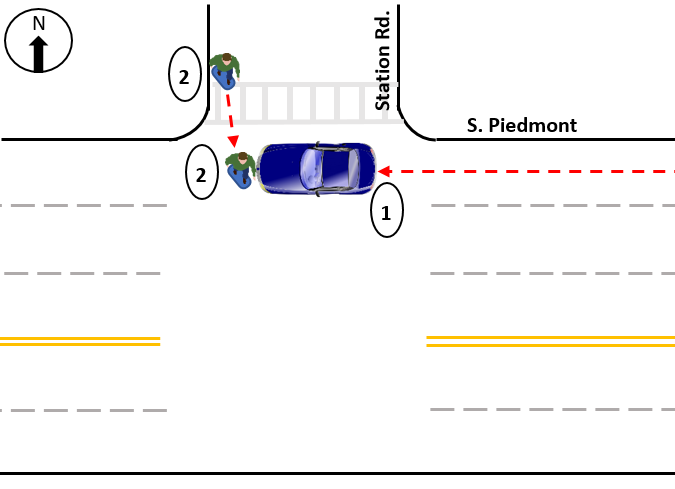
Non-Motorist Location at Time of Crash (Unit 2)
Element Definition: The location of the non-motorist with respect to the roadway at the time of the crash.
Intersection – Marked Crosswalk
Intersection – Unmarked Crosswalk
Intersection – Other
Median/Crossing Island
Shoulder/Roadside
Travel Lane – Other Location
Other
Unknown
Total Lanes in Roadway - Through Lanes (Unit 1)
Element Definition: Total number of lanes in the roadway on which this motor vehicle was traveling. Through lanes also include shared through/turn lanes but exclude turn-only lanes’ auxiliary lanes, such as collector-distributor lanes, weaving lanes, frontage road lanes, parking lanes, acceleration/deceleration lanes, toll collection lanes, and truck climbing lanes. Total lanes are collected in two parts as total through lanes and total auxiliary lanes.
0 Lanes
1 Lane
2 Lanes
3 Lanes
4 Lanes
5 Lanes
6 Lanes
Total Lanes in Roadway - Auxiliary Lanes (Unit 1)
Element Definition: Total number of lanes in the roadway on which this motor vehicle was traveling. Through lanes also include shared through/turn lanes but exclude turn-only lanes’ auxiliary lanes, such as collector-distributor lanes, weaving lanes, frontage road lanes, parking lanes, acceleration/deceleration lanes, toll collection lanes, and truck climbing lanes. Total lanes are collected in two parts as total through lanes and total auxiliary lanes.
0 Lanes
1 Lane
2 Lanes
3 Lanes
4 Lanes
5 Lanes
6 Lanes
Type of intersection - Subfield 1: Number of Approaches
Element Definition: An intersection consists of two or more roadways that intersect at the same level.
Not an Intersection
(2) Two
(3) Three
(4) Four
(5+) Five or more
Type of intersection - Subfield 2: Overall Intersection Geometry
Element Definition: An intersection consists of two or more roadways that intersect at the same level.
Angled/Skewed
Roundabout/Traffic Circle
Perpendicular
Not Applicable/Not an Intersection
Type of intersection - Subfield 3: Overall Traffic Control Device
Element Definition: An intersection consists of two or more roadways that intersect at the same level.
Signalized
Stop – All Way
Stop – Partial
Yield
No Controls
Not Applicable/Not an Intersection
Direction of Travel before Crash (Unit 1)
Element Definition: The direction of a motor vehicle’s travel on the roadway before the crash. Notice that this is not a compass direction, but a direction consistent with the designated direction of the road. For example, the direction of a State-designated North-South highway must be either northbound or southbound even though a motor vehicle may have been traveling due east as a result of a short segment of the highway having an east-west orientation.
Not on Roadway
Northbound
Eastbound
Southbound
Westbound
Unknown
Person Type (Unit 2)
Element Definition: Type of person involved in a crash.
Driver
Passenger
Occupant of Motor Vehicle Not in Transport
Bicyclist
Other Cyclist
Pedestrian
Other Pedestrian (wheelchair, person in a building, skater, personal conveyance, etc.)
Occupant of a Non-Motor Vehicle Transport Device
Unknown Type of Non-Motorist
Unknown
Non-Motorist Action/Circumstances Prior to Crash (Unit 2)
Element Definition: The action of the non-motorist immediately prior to the crash
None
Stationary and Adjacent to Roadway (e.g., Shoulder, Median, Sidewalk)
Crossing Roadway
In Roadway - Other
Waiting to Cross Roadway
Walking/Cycling Along Roadway Against Traffic (In or Adjacent to Travel Lane)
Walking/Cycling Along Roadway with Traffic (In or Adjacent to Travel Lane)
Walking/Cycling on Sidewalk
Working in Trafficway (Incident Response)
Other
Unknown
Non-Motorist Contributing Action(s)/Circumstance(s) (Unit 2)
Element Definition: The actions/circumstances of the non-motorist that may have contributed to the crash. This data element is based on the judgment of the law enforcement officer investigating the crash.
Select up to 2
None (No Improper Action)
Dart/Dash
Failure to Obey Traffic Signs, Signals, or Officer
Failure to Yield Right-Of-Way
Improper Turn/Merge
Inattentive (Talking, Eating, etc.)
In Roadway Improperly (Standing, Lying, Working, Playing)
Not Visible (Dark Clothing, No Lighting, etc.)
Wrong-Way Riding or Walking
Other
Unknown
Scenario 2:
Complete the data elements based on the following diagram.
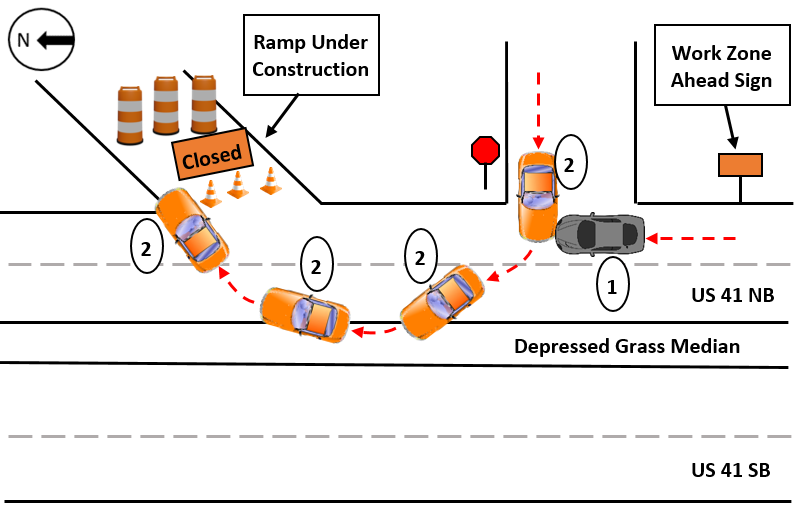
Relation to Junction
Element Definition: The coding of this data element is based on the location of the First Harmful Event of the crash. It identifies the crash’s location with respect to presence in a junction or proximity to components typically in junction or interchange areas.
Non-Junction
Acceleration/Deceleration Lane
Crossover-Related
Driveway Access or Related
Entrance/Exit Ramp or Related
Intersection or Related
Railway Grade Crossing
Shared-Use Path or Trail
Through Roadway
Other Location Not Listed Above Within an Interchange Area (median, shoulder, and roadside)
Unknown
Work Zone-Related - Subfield 1: Was the crash in a construction, maintenance, or utility work zone or was it related to activity within a work zone?
Element Definition: A crash that occurs in or related to a construction, maintenance, or utility work zone, whether workers were present at the time of the crash or not. “Work zone-related” crashes may also include those involving motor vehicles slowed or stopped because of the work zone, even if the First Harmful Event occurred before the first warning sign.
No
Yes
Unknown
Work Zone-Related - Subfield 2: Location of the Crash
Element Definition: A crash that occurs in or related to a construction, maintenance, or utility work zone, whether workers were present at the time of the crash or not. “Work zone-related” crashes may also include those involving motor vehicles slowed or stopped because of the work zone, even if the First Harmful Event occurred before the first warning sign.
Before the First Work Zone Warning Sign
Advance Warning Area
Transition Area
Activity Area
Termination Area
Not Applicable/Not Within or Related to a Work Zone
Work Zone-Related - Subfield 3: Type of Work Zone
Element Definition: A crash that occurs in or related to a construction, maintenance, or utility work zone, whether workers were present at the time of the crash or not. “Work zone-related” crashes may also include those involving motor vehicles slowed or stopped because of the work zone, even if the First Harmful Event occurred before the first warning sign.
Lane Closure
Lane Shift/Crossover
Work on Shoulder or Median
Intermittent or Moving Work
Other Type of Work Zone
Not Applicable/Not Within or Related to a Work Zone
Total Lanes in Roadway - Through Lanes (Unit 1)
Element Definition: Total number of lanes in the roadway on which this motor vehicle was traveling. Through lanes also include shared through/turn lanes but exclude turn-only lanes’ auxiliary lanes, such as collector-distributor lanes, weaving lanes, frontage road lanes, parking lanes, acceleration/deceleration lanes, toll collection lanes, and truck climbing lanes. Total lanes are collected in two parts as total through lanes and total auxiliary lanes.
0 Lanes
1 Lane
2 Lanes
3 Lanes
4 Lanes
5 or more Lanes
Total Lanes in Roadway - Auxiliary Lanes (Unit 1)
Element Definition: Total number of lanes in the roadway on which this motor vehicle was traveling. Through lanes also include shared through/turn lanes but exclude turn-only lanes’ auxiliary lanes, such as collector-distributor lanes, weaving lanes, frontage road lanes, parking lanes, acceleration/deceleration lanes, toll collection lanes, and truck climbing lanes. Total lanes are collected in two parts as total through lanes and total auxiliary lanes.
0 Lanes
1 Lane
2 Lanes
3 Lanes
4 Lanes
5 or more Lanes
Trafficway Description Subfield 1: Travel Directions (Unit 1)
Element Definition: Indication of whether the trafficway for this vehicle is divided, whether it serves one-way or two-way traffic, and the type of lane this vehicle was using. Subfield 1 identifies whether the trafficway associated with this vehicle serves one-way or two-way traffic.
One-Way
Two-Way
Trafficway Description - Subfield 2: Divided? (Unit 1)
Element Definition: Indication of whether the trafficway for this vehicle is divided, whether it serves one-way or two-way traffic, and the type of lane this vehicle was using. Subfield 2 identifies whether or not the trafficway for this vehicle is divided.
Not Divided
Not Divided, with a Continuous Left-Turn Lane
Divided, Flush Median (greater than 4ft wide)
Divided, Raise Median (curbed)
Divided, Depressed Median
Unknown
Large Vehicle 1:
Complete the data elements for the following vehicle.
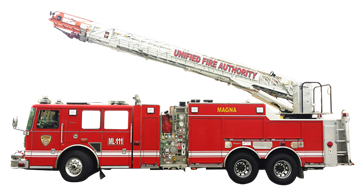
Vehicle Configuration
Element Definition: Indicates the general configuration of this motor vehicle.
Vehicle 10,000 lbs. or Less Placarded for Hazardous Materials
Bus/Large Van (seats for 9-15 occupants, including driver)
Bus (seats more than 15 occupants, including driver)
Single-Unit Truck (2-axle and GVWR > 10,000 lbs.)
Single-Unit Truck (3 or more axles)
Truck Pulling Trailer(s)
Truck Tractor (Bobtail)
Truck Tractor/Semi-Trailer
Truck Tractor/Double
Truck Tractor/Triple
Vehicle More Than 10,000 lbs., Other
Qualifying Vehicle, Unknown Configuration
Unknown
Cargo Body Type
Element Definition: The type of body for buses and trucks more than 10,000 GVWR.
No Cargo Body (bobtail, light motor vehicle with hazardous materials placard, etc.)
Bus
Auto Transporter
Cargo Tank
Concrete Mixer
Dump
Flatbed
Garbage/Refuse
Grain/Chips/Gravel
Intermodal Container Chassis
Log
Pole-Trailer
Van/Enclosed Box
Vehicle Towing Another Vehicle
Not Applicable (motor vehicle 10,000 lbs. or less, not displaying hazardous materials placard)
Other
Unknown
Large Vehicle 2:
Complete the data elements for the following vehicle.
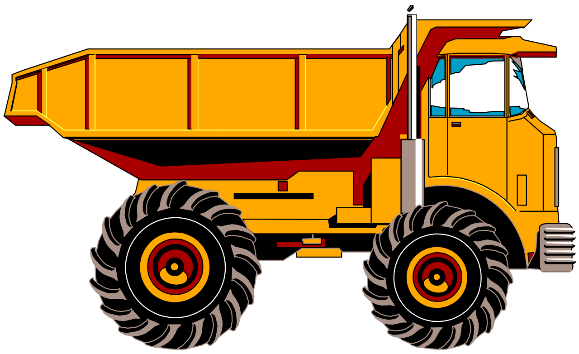
Vehicle Configuration
Element Definition: Indicates the general configuration of this motor vehicle.
Vehicle 10,000 lbs. or Less Placarded for Hazardous Materials
Bus/Large Van (seats for 9-15 occupants, including driver)
Bus (seats more than 15 occupants, including driver)
Single-Unit Truck (2-axle and GVWR > 10,000 lbs.)
Single-Unit Truck (3 or more axles)
Truck Pulling Trailer(s)
Truck Tractor (Bobtail)
Truck Tractor/Semi-Trailer
Truck Tractor/Double
Truck Tractor/Triple
Vehicle More Than 10,000 lbs., Other
Qualifying Vehicle, Unknown Configuration
Unknown
Cargo Body Type
Element Definition: The type of body for buses and trucks more than 10,000 GVWR.
No Cargo Body (bobtail, light motor vehicle with hazardous materials placard, etc.)
Bus
Auto Transporter
Cargo Tank
Concrete Mixer
Dump
Flatbed
Garbage/Refuse
Grain/Chips/Gravel
Intermodal Container Chassis
Log
Pole-Trailer
Van/Enclosed Box
Vehicle Towing Another Vehicle
Not Applicable (motor vehicle 10,000 lbs. or less, not displaying hazardous materials placard)
Other
Unknown
Format Review: Type of Intersection
Review two different formats for the data element "Type of Intersection."
Element Definition: An intersection consists of two or more roadways that intersect at the same level.
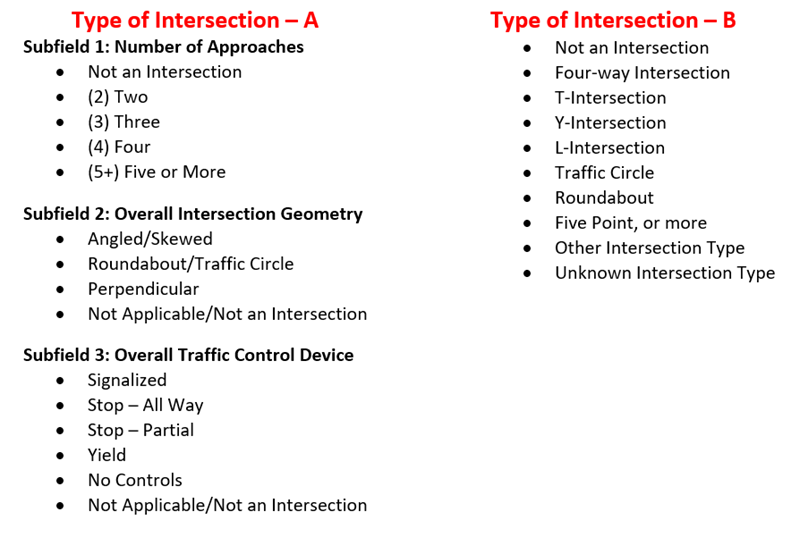
Which format would you prefer to see on a crash report form?
Type of Intersection – A
Type of Intersection – B
Explain your preference
Scenario 3:
Complete the data elements based on the following scenario and diagram.
The driver of Vehicle 1 (blue car) did not see Vehicle 2 (motorcycle) and turned right onto Bowman Rd. Vehicle 2 (motorcycle) swerved to avoid Vehicle 1 and lost control. The driver of Vehicle 2 laid down the motorcycle and they both began to slide. The driver became separated, flew off the left side of the roadway, and struck a tree. The motorcycle remained on the roadway. The driver of Vehicle 2 sustained minor abrasive injuries from the impact with the road and life-threatening injuries from the impact with the tree.

First Harmful Event
Element Definition: The first harmful event is defined as the first injury- or damage-producing event of the crash.
Fell/Jumped from Motor Vehicle
Overturn/Rollover
Motor Vehicle In-Transport
Struck by Falling, Shifting Cargo or Anything Set in Motion by Motor Vehicle
Tree (standing)
Sequence of Events (Unit 2)
Element Definition: The sequence of events are events in sequence related to this motor vehicle, including non-harmful events, non-collision harmful events, and collision events.
1. Separation of Units, 2. Cross Centerline, 3. Ran Off Roadway Left, 4. Tree (Standing)
1. Fell/Jumped from Motor Vehicle, 2. Cross Centerline, 3. Ran Off Roadway Left, 4. Tree (standing)
1. Overturn/Rollover, 2. Ran Off Roadway Left, 3. Tree (standing)
1. Overturn/Rollover, 2. Cross Centerline, 3. Tree (standing)
1. Motor Vehicle In-Transport, 2. Overturn/Rollover, 3. Tree (standing)
Most Harmful Event for This Motor Vehicle (Unit 2)
Element Definition: Event that resulted in the most severe injury or, if no injury, the greatest property damage involving this motor vehicle.
Overturn/Rollover
Fell/Jumped from Motor Vehicle
Tree (standing)
Motor Vehicle In-Transport
Scenario 4:
Complete the following data elements for Unit 1 in this example.
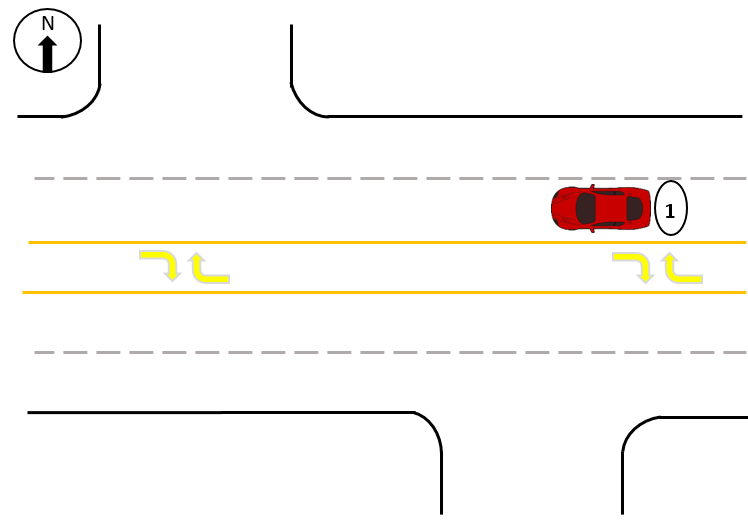
Total Lanes in Roadway - Through Lanes (Unit 1)
Element Definition: Total number of lanes in the roadway on which this motor vehicle was traveling. Through lanes also include shared through/turn lanes but exclude turn-only lanes’ auxiliary lanes, such as collector-distributor lanes, weaving lanes, frontage road lanes, parking lanes, acceleration/deceleration lanes, toll collection lanes, and truck climbing lanes. Total lanes are collected in two parts as total through lanes and total auxiliary lanes.
0 Lanes
1 Lane
2 Lanes
3 Lanes
4 Lanes
5 or more Lanes
Total Lanes in Roadway - Auxiliary Lanes (Unit 1)
Element Definition: Total number of lanes in the roadway on which this motor vehicle was traveling. Through lanes also include shared through/turn lanes but exclude turn-only lanes’ auxiliary lanes, such as collector-distributor lanes, weaving lanes, frontage road lanes, parking lanes, acceleration/deceleration lanes, toll collection lanes, and truck climbing lanes. Total lanes are collected in two parts as total through lanes and total auxiliary lanes.
0 Lanes
1 Lane
2 Lanes
3 Lanes
4 Lanes
5 or more Lanes
Trafficway Description Subfield 1: Travel Directions (Unit 1)
Element Definition: Indication of whether the trafficway for this vehicle is divided, whether it serves one-way or two-way traffic, and the type of lane this vehicle was using. Subfield 1 identifies whether the trafficway associated with this vehicle serves one-way or two-way traffic.
One-Way
Two-Way
Trafficway Description - Subfield 2: Divided? (Unit 1)
Element Definition: Indication of whether the trafficway for this vehicle is divided, whether it serves one-way or two-way traffic, and the type of lane this vehicle was using. Subfield 2 identifies whether or not the trafficway for this vehicle is divided.
Not Divided
Not Divided, with a Continuous Left-Turn Lane
Divided, Flush Median (greater than 4ft wide)
Divided, Raise Median (curbed)
Divided, Depressed Median
Unknown
Scenario 5:
Complete the data element Special Function of Motor Vehicle in-Transport for the vehicle in each example.
Element Definition: The type of special function being served by this motor vehicle in-transport regardless of whether the function is marked on the vehicle or aligns to the body type, at the time of the crash. For example, a 15-Passenger van being used as a school bus.
Example 1: A school bus body type, privately-owned, and converted to transport a music band cross-country.
No Special Function
Charter/Tour Bus
Childcare/Daycare Bus
Fire Truck
Police
Rental Truck (Over 10,000 lbs.)
Transit/Commuter Bus
Example 2: A privately-owned minivan used by a parent to transport 6 neighborhood children to school.
No Special Function
Charter/Tour Bus
Childcare/Daycare Bus
Fire Truck
Police
Rental Truck (Over 10,000 lbs.)
Transit/Commuter Bus
Example 3: An off-duty police vehicle.
No Special Function
Police
Other Incident Response
Safety Service Patrols – Incident Response
Example 4: An off-duty taxi.
No Special Function
Taxi
Vehicle Used for Electronic Ride-hailing (transportation network company)
Scenario 6:
Complete the data elements for Unit 1 (yellow vehicle) based on the following scenario and diagram.
Unit 1 (yellow vehicle) was traveling east on Tea Tree Road behind a school bus. Unit 2 (blue vehicle) was traveling west on Tea Tree Road. The school bus slowed to a stop to let children off and extended the stop sign arm and turned on the flashing lights. Unit 2 had begun passing the school bus prior to the school bus stopping. The driver of Unit 1 had been changing the radio station in the vehicle and did not notice the school bus slowing. The driver of Unit 1 looked up from the radio, saw the bus had stopped, quickly swerved into the oncoming lane to avoid the bus, and impacted Unit 2.

School Bus Related
Element Definition: Indicates whether a school bus or motor vehicle functioning as a school bus for a school-related purpose is involved in the crash. The “school bus,” with or without a passenger on board, must be directly involved as a contact motor vehicle or indirectly involved as a non-contact motor vehicle (children struck when boarding or alighting from the school bus, two vehicles colliding as the result of the stopped school bus, etc.).
No
Yes, School Bus Directly Involved
Yes, School Bus Indirectly Involved
Attempted Avoidance Maneuver (Unit 1)
Element Definition: This element identifies movements/actions taken by the driver after the driver realizes there is an impending danger. This element assesses what the driver action was in response to his/her realization.
No Driver Present/Unknown if Driver Present
Accelerating and Steering Left
Accelerating and Steering Right
Braking and Steering Left
Braking and Steering Right
Braking (Lockup)
Braking (Lockup Unknown)
Braking (No Lockup)
No Avoidance Maneuver
Releasing Brakes
Steering Left
Steering Right
Lay Down Motorcycle
Other Actions
Unknown
Driver Actions at Time of Crash (Unit 1)
Select up to 4
Element Definition: The actions by the driver that may have contributed to the crash. This data element is based on the judgment of the law enforcement officer investigating the crash and need not match Violation Codes.
No Contributing Action
Failed to Keep in Proper Lane
Failed to Yield Right-of-Way
Improper Passing
Operated Motor Vehicle in Inattentive, Careless, Negligent, or Erratic Manner
Other Contributing Action
Disregarded Other Traffic Sign
Followed Too Closely
Swerved or Avoided Due to Wind, Slippery Surface, Motor Vehicle, Object, Non-Motorist, or Animal in Roadway, etc.
Distracted By, Subfield 1: Action (Unit 1)
Element Definition: Distractions that may have influenced driver/non-motorist performance, involving both an action taken by the driver/non-motorist and the source of the distraction.
Not Distracted
Talking/Listening
Manually Operating (texting, dialing, playing game, etc.)
Other Action (looking away from task, etc.)
Unknown
Distracted By, Subfield 2: Source (Unit 1)
Element Definition: Distractions that may have influenced driver/non-motorist performance, involving both an action taken by the driver/non-motorist and the source of the distraction.
Hands-Free Mobile Phone
Hand-Held Mobile Phone
Other Electronic Device
Vehicle-Integrated Device
Passenger/Other Non-Motorist
External (to vehicle/non-motorist area)
Other Distraction (animal, food, grooming)
Not Applicable (Not Distracted)
Unknown
Directions
In the following exercises you will be asked to review crash data elements and answer two questions about each.
1.) Please rate the following statements for this data element using a scale of 1-5, with 1 meaning Strongly Agree and 5 meaning Strongly Disagree.
This data element is clearly defined and understandable.
This data element can be collected at the scene of a crash.
This data element can be completed based on facts, not speculation.
This data element has a reasonable number of selections.
2.) Reflecting on your answers above, could this data element be improved? If so, how?
Please answer each question to the best of your ability. The more detailed the answer, the more helpful it will be toward improving future editions of the MMUCC guidelines.
Data Element Review: Type of Intersection
Review the data element and answer the following questions.
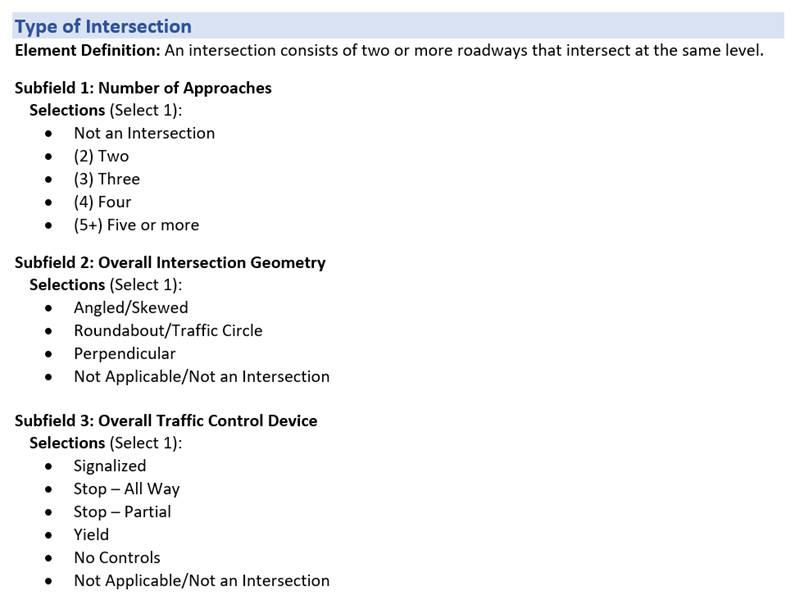
Please rate the following statements for this data element using a scale of 1-5, with 1 meaning Strongly Agree and 5 meaning Strongly Disagree.
|
1-Strongly Agree |
2-Agree |
3-Neutral |
4-Disagree |
5-Strongly Disagree |
This data element is clearly defined and understandable |
|
|
|
|
|
This data element can be collected at the scene of a crash |
|
|
|
|
|
This data element can be completed based on facts, not speculation |
|
|
|
|
|
This data element has a reasonable number of selections |
|
|
|
|
|
Reflecting on your answers above, could this data element be improved? If so, how?
Data Element Review: Attempted Avoidance Maneuver
Review the data element and answer the following questions.
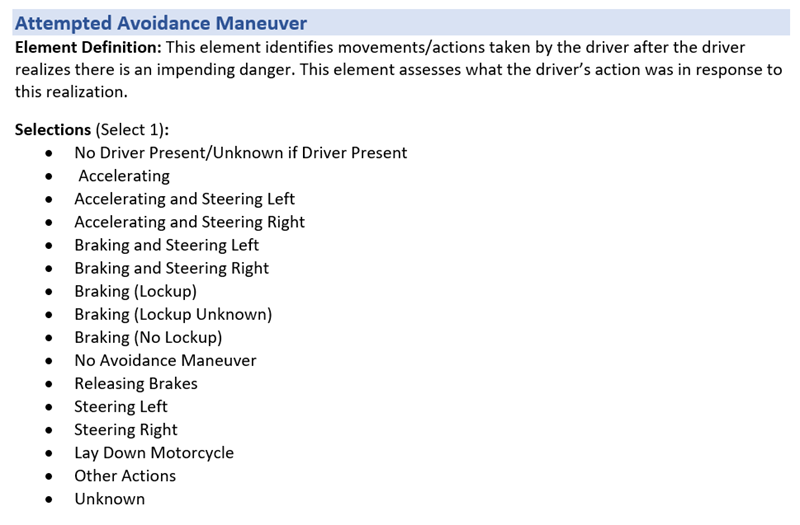
Please rate the following statements for this data element using a scale of 1-5, with 1 meaning Strongly Agree and 5 meaning Strongly Disagree.
|
1-Strongly Agree |
2-Agree |
3-Neutral |
4-Disagree |
5-Strongly Disagree |
This data element is clearly defined and understandable |
|
|
|
|
|
This data element can be collected at the scene of a crash |
|
|
|
|
|
This data element can be completed based on facts, not speculation |
|
|
|
|
|
This data element has a reasonable number of selections |
|
|
|
|
|
Reflecting on your answers above, could this data element be improved? If so, how?
Data Element Review: Distracted By
Review the data element and answer the following questions.

Please rate the following statements for this data element using a scale of 1-5, with 1 meaning Strongly Agree and 5 meaning Strongly Disagree.
|
1-Strongly Agree |
2-Agree |
3-Neutral |
4-Disagree |
5-Strongly Disagree |
This data element is clearly defined and understandable |
|
|
|
|
|
This data element can be collected at the scene of a crash |
|
|
|
|
|
This data element can be completed based on facts, not speculation |
|
|
|
|
|
This data element has a reasonable number of selections |
|
|
|
|
|
Reflecting on your answers above, could this data element be improved? If so, how?
Data Element Review: Work Zone-Related
Review the data element and answer the following questions.
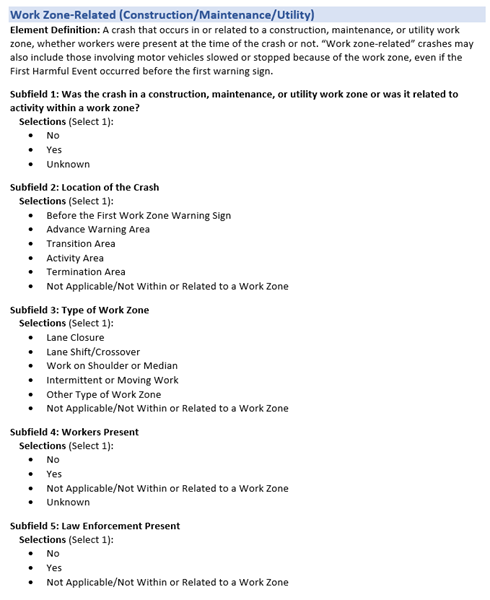
Please rate the following statements for this data element using a scale of 1-5, with 1 meaning Strongly Agree and 5 meaning Strongly Disagree.
|
1-Strongly Agree |
2-Agree |
3-Neutral |
4-Disagree |
5-Strongly Disagree |
This data element is clearly defined and understandable |
|
|
|
|
|
This data element can be collected at the scene of a crash |
|
|
|
|
|
This data element can be completed based on facts, not speculation |
|
|
|
|
|
This data element has a reasonable number of selections |
|
|
|
|
|
Reflecting on your answers above, could this data element be improved? If so, how?
Data Element Review: Non-Motorist Location at Time of the Crash
Review the data element and answer the following questions.
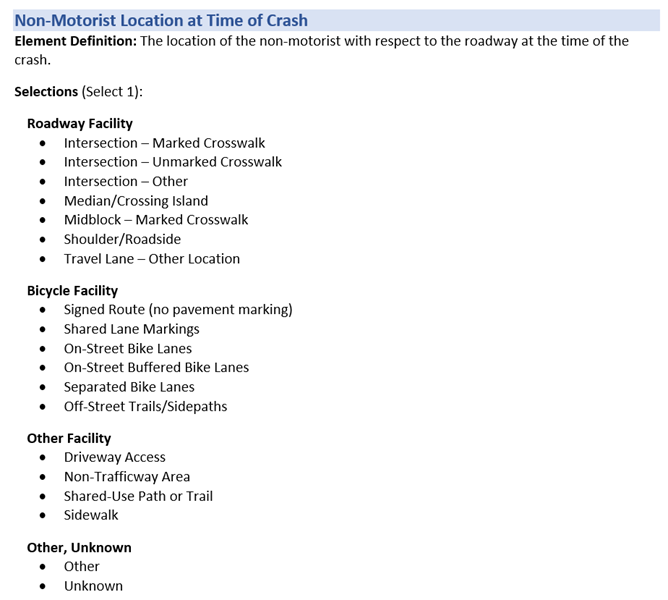
Please rate the following statements for this data element using a scale of 1-5, with 1 meaning Strongly Agree and 5 meaning Strongly Disagree.
|
1-Strongly Agree |
2-Agree |
3-Neutral |
4-Disagree |
5-Strongly Disagree |
This data element is clearly defined and understandable |
|
|
|
|
|
This data element can be collected at the scene of a crash |
|
|
|
|
|
This data element can be completed based on facts, not speculation |
|
|
|
|
|
This data element has a reasonable number of selections |
|
|
|
|
|
Reflecting on your answers above, could this data element be improved? If so, how?
Data Element Review: Non-Motorist Contributing Action(s)/Circumstances(s)
Review the data element and answer the following questions.
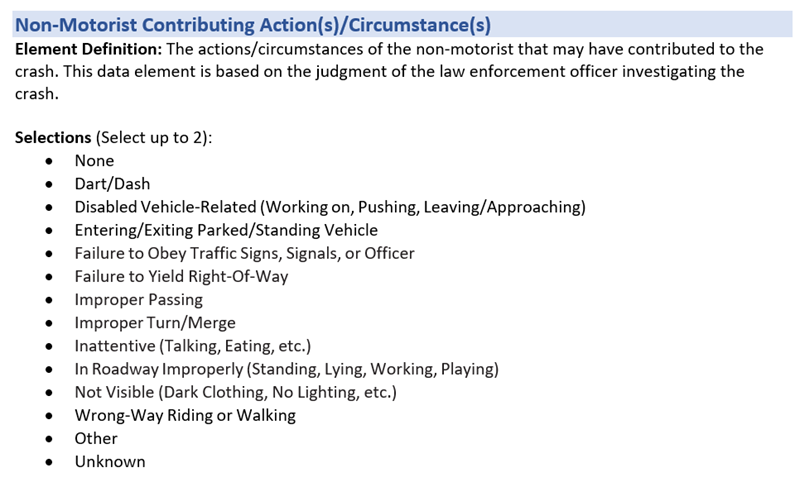
Please rate the following statements for this data element using a scale of 1-5, with 1 meaning Strongly Agree and 5 meaning Strongly Disagree.
|
1-Strongly Agree |
2-Agree |
3-Neutral |
4-Disagree |
5-Strongly Disagree |
This data element is clearly defined and understandable |
|
|
|
|
|
This data element can be collected at the scene of a crash |
|
|
|
|
|
This data element can be completed based on facts, not speculation |
|
|
|
|
|
This data element has a reasonable number of selections |
|
|
|
|
|
Reflecting on your answers above, could this data element be improved? If so, how?
Data Element Review: Total Lanes in Roadway
Review the data element and answer the following questions.
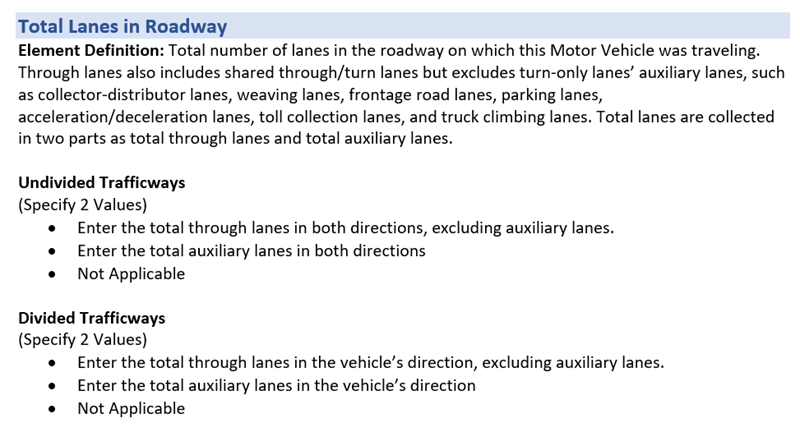
Please rate the following statements for this data element using a scale of 1-5, with 1 meaning Strongly Agree and 5 meaning Strongly Disagree.
|
1-Strongly Agree |
2-Agree |
3-Neutral |
4-Disagree |
5-Strongly Disagree |
This data element is clearly defined and understandable |
|
|
|
|
|
This data element can be collected at the scene of a crash |
|
|
|
|
|
This data element can be completed based on facts, not speculation |
|
|
|
|
|
This data element has a reasonable number of selections |
|
|
|
|
|
Reflecting on your answers above, could this data element be improved? If so, how?
Data Element Review: Trafficway Description
Review the data element and answer the following questions.

Please rate the following statements for this data element using a scale of 1-5, with 1 meaning Strongly Agree and 5 meaning Strongly Disagree.
|
1-Strongly Agree |
2-Agree |
3-Neutral |
4-Disagree |
5-Strongly Disagree |
This data element is clearly defined and understandable |
|
|
|
|
|
This data element can be collected at the scene of a crash |
|
|
|
|
|
This data element can be completed based on facts, not speculation |
|
|
|
|
|
This data element has a reasonable number of selections |
|
|
|
|
|
Reflecting on your answers above, could this data element be improved? If so, how?
Data Element Review: School Bus-Related
Review the data element and answer the following questions.
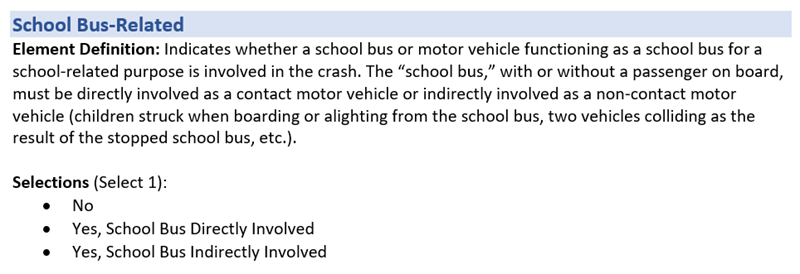
Please rate the following statements for this data element using a scale of 1-5, with 1 meaning Strongly Agree and 5 meaning Strongly Disagree.
|
1-Strongly Agree |
2-Agree |
3-Neutral |
4-Disagree |
5-Strongly Disagree |
This data element is clearly defined and understandable |
|
|
|
|
|
This data element can be collected at the scene of a crash |
|
|
|
|
|
This data element can be completed based on facts, not speculation |
|
|
|
|
|
This data element has a reasonable number of selections |
|
|
|
|
|
Reflecting on your answers above, could this data element be improved? If so, how?
Data Element Review: Vehicle Configuration
Review the data element and answer the following questions.
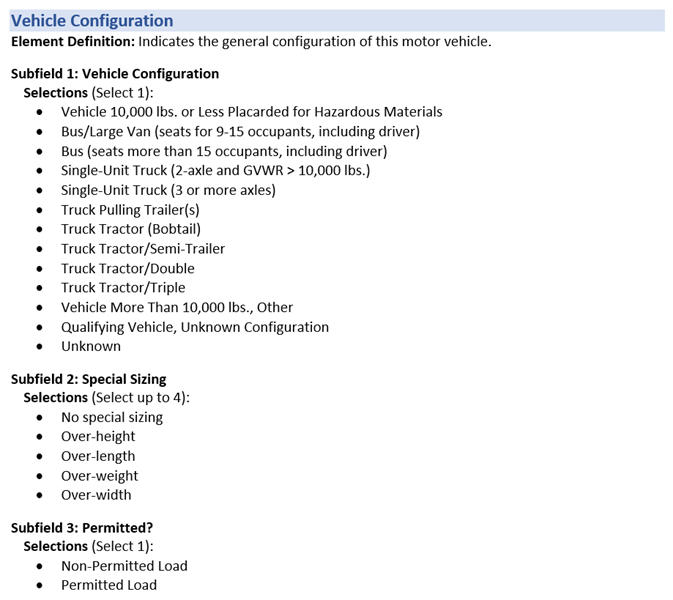
Please rate the following statements for this data element using a scale of 1-5, with 1 meaning Strongly Agree and 5 meaning Strongly Disagree.
|
1-Strongly Agree |
2-Agree |
3-Neutral |
4-Disagree |
5-Strongly Disagree |
This data element is clearly defined and understandable |
|
|
|
|
|
This data element can be collected at the scene of a crash |
|
|
|
|
|
This data element can be completed based on facts, not speculation |
|
|
|
|
|
This data element has a reasonable number of selections |
|
|
|
|
|
Reflecting on your answers above, could this data element be improved? If so, how?
Data Element Review: Sequence of Events
Review the data element and answer the following questions.
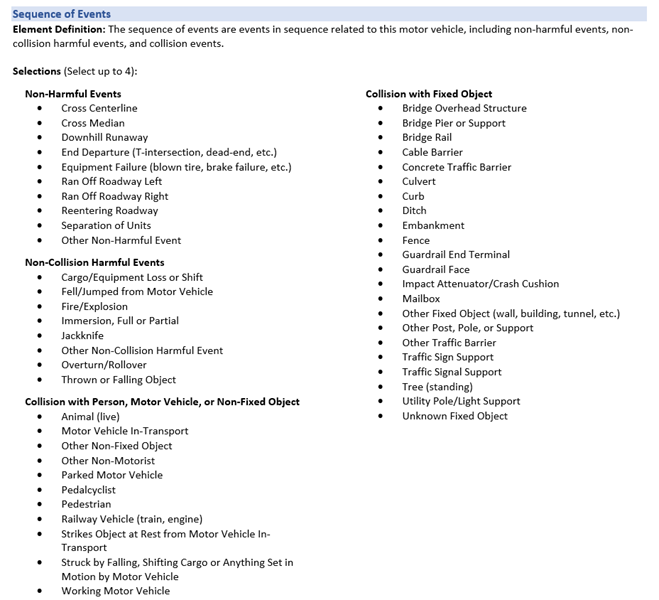
Please rate the following statements for this data element using a scale of 1-5, with 1 meaning Strongly Agree and 5 meaning Strongly Disagree.
|
1-Strongly Agree |
2-Agree |
3-Neutral |
4-Disagree |
5-Strongly Disagree |
This data element is clearly defined and understandable |
|
|
|
|
|
This data element can be collected at the scene of a crash |
|
|
|
|
|
This data element can be completed based on facts, not speculation |
|
|
|
|
|
This data element has a reasonable number of selections |
|
|
|
|
|
Reflecting on your answers above, could this data element be improved? If so, how?
Data Element Review: Direction of Travel Before Crash
Review the data element and answer the following questions.
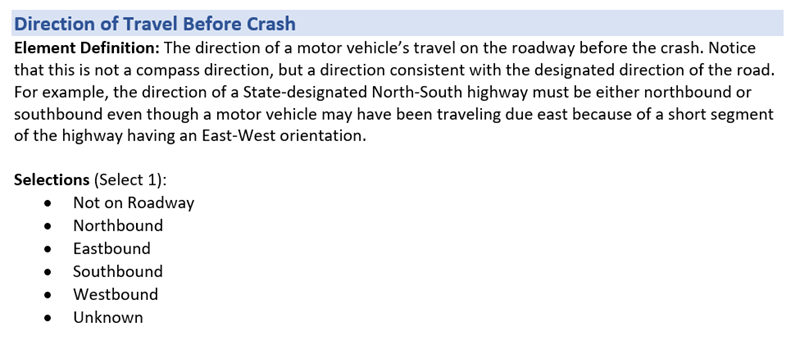
Please rate the following statements for this data element using a scale of 1-5, with 1 meaning Strongly Agree and 5 meaning Strongly Disagree.
|
1-Strongly Agree |
2-Agree |
3-Neutral |
4-Disagree |
5-Strongly Disagree |
This data element is clearly defined and understandable |
|
|
|
|
|
This data element can be collected at the scene of a crash |
|
|
|
|
|
This data element can be completed based on facts, not speculation |
|
|
|
|
|
This data element has a reasonable number of selections |
|
|
|
|
|
Reflecting on your answers above, could this data element be improved? If so, how?
Data Element Review: Special Function of Motor Vehicle In-Transport
Review the data element and answer the following questions.

Please rate the following statements for this data element using a scale of 1-5, with 1 meaning Strongly Agree and 5 meaning Strongly Disagree.
|
1-Strongly Agree |
2-Agree |
3-Neutral |
4-Disagree |
5-Strongly Disagree |
This data element is clearly defined and understandable |
|
|
|
|
|
This data element can be collected at the scene of a crash |
|
|
|
|
|
This data element can be completed based on facts, not speculation |
|
|
|
|
|
This data element has a reasonable number of selections |
|
|
|
|
|
Reflecting on your answers above, could this data element be improved? If so, how?
Data Element Review: Cargo Body Type
Review the data element and answer the following questions.
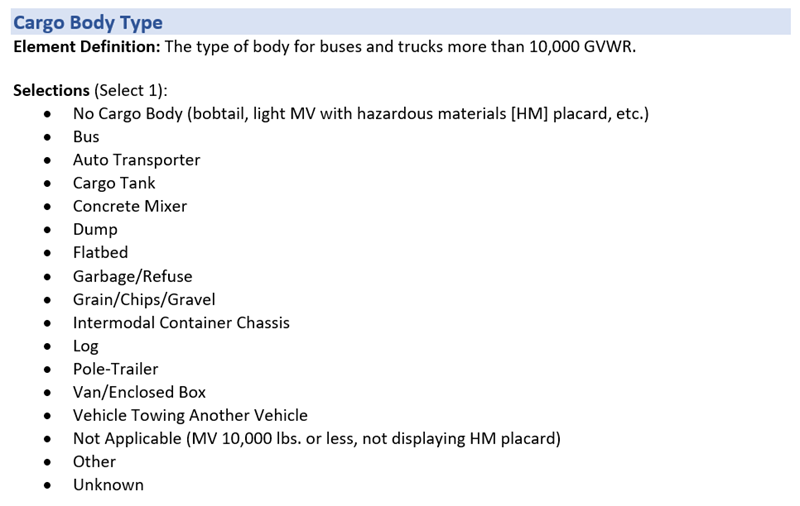
Please rate the following statements for this data element using a scale of 1-5, with 1 meaning Strongly Agree and 5 meaning Strongly Disagree.
|
1-Strongly Agree |
2-Agree |
3-Neutral |
4-Disagree |
5-Strongly Disagree |
This data element is clearly defined and understandable |
|
|
|
|
|
This data element can be collected at the scene of a crash |
|
|
|
|
|
This data element can be completed based on facts, not speculation |
|
|
|
|
|
This data element has a reasonable number of selections |
|
|
|
|
|
Reflecting on your answers above, could this data element be improved? If so, how?
Data Element Review: Contributing Circumstances – Roadway Environment
Review the data element and answer the following questions.
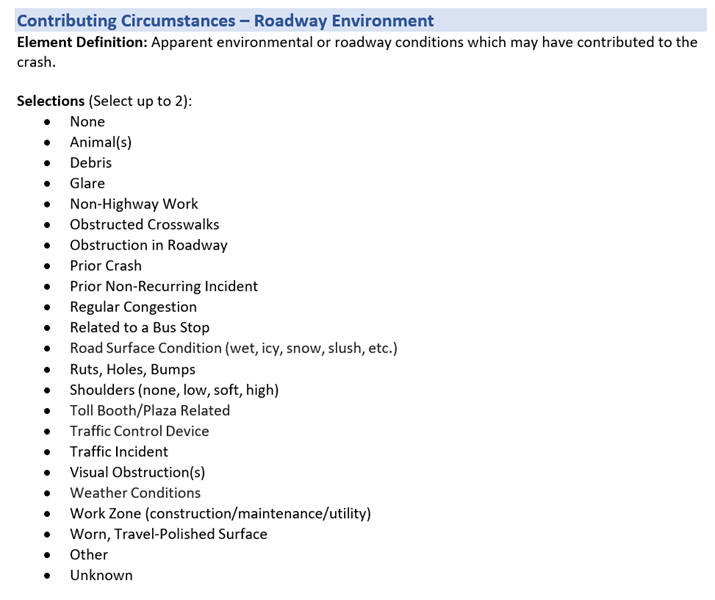
Please rate the following statements for this data element using a scale of 1-5, with 1 meaning Strongly Agree and 5 meaning Strongly Disagree.
|
1-Strongly Agree |
2-Agree |
3-Neutral |
4-Disagree |
5-Strongly Disagree |
This data element is clearly defined and understandable |
|
|
|
|
|
This data element can be collected at the scene of a crash |
|
|
|
|
|
This data element can be completed based on facts, not speculation |
|
|
|
|
|
This data element has a reasonable number of selections |
|
|
|
|
|
Reflecting on your answers above, could this data element be improved? If so, how?
Data Element Review: Estimated Travel Speed of Motor Vehicle In-Transport
Review the data element and answer the following questions.
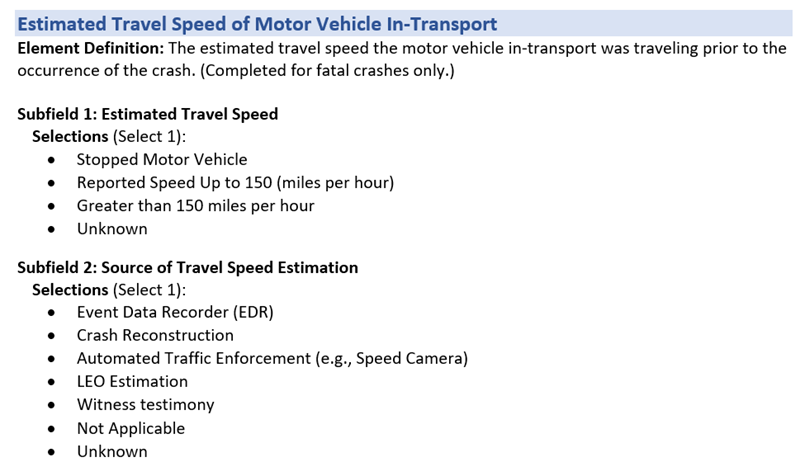
Please rate the following statements for this data element using a scale of 1-5, with 1 meaning Strongly Agree and 5 meaning Strongly Disagree.
|
1-Strongly Agree |
2-Agree |
3-Neutral |
4-Disagree |
5-Strongly Disagree |
This data element is clearly defined and understandable |
|
|
|
|
|
This data element can be collected at the scene of a crash |
|
|
|
|
|
This data element can be completed based on facts, not speculation |
|
|
|
|
|
This data element has a reasonable number of selections |
|
|
|
|
|
Reflecting on your answers above, could this data element be improved? If so, how?
Data Element Review: Hazardous Materials
Review the data element and answer the following questions.
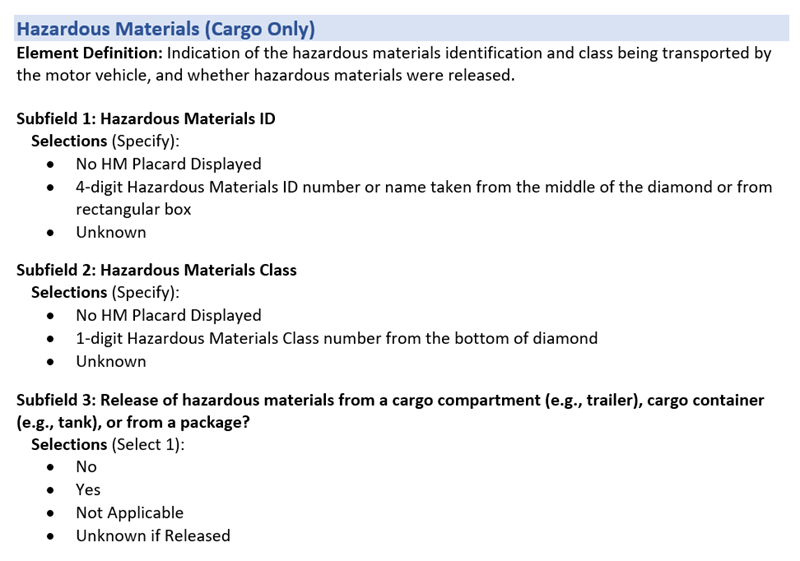
Please rate the following statements for this data element using a scale of 1-5, with 1 meaning Strongly Agree and 5 meaning Strongly Disagree.
|
1-Strongly Agree |
2-Agree |
3-Neutral |
4-Disagree |
5-Strongly Disagree |
This data element is clearly defined and understandable |
|
|
|
|
|
This data element can be collected at the scene of a crash |
|
|
|
|
|
This data element can be completed based on facts, not speculation |
|
|
|
|
|
This data element has a reasonable number of selections |
|
|
|
|
|
Reflecting on your answers above, could this data element be improved? If so, how?
Data Element Review: Helmet Use
Review the data element and answer the following questions.
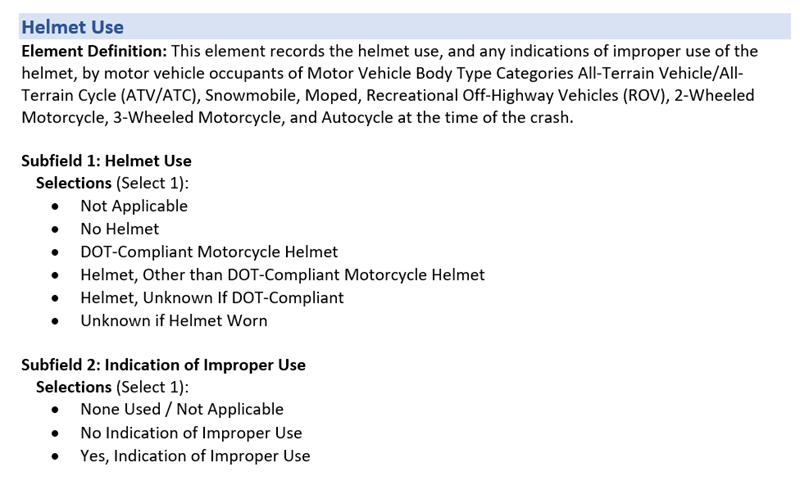
Please rate the following statements for this data element using a scale of 1-5, with 1 meaning Strongly Agree and 5 meaning Strongly Disagree.
|
1-Strongly Agree |
2-Agree |
3-Neutral |
4-Disagree |
5-Strongly Disagree |
This data element is clearly defined and understandable |
|
|
|
|
|
This data element can be collected at the scene of a crash |
|
|
|
|
|
This data element can be completed based on facts, not speculation |
|
|
|
|
|
This data element has a reasonable number of selections |
|
|
|
|
|
Reflecting on your answers above, could this data element be improved? If so, how?
Data Element Review: Law Enforcement Suspects Alcohol Use
Review the data element and answer the following questions.

Please rate the following statements for this data element using a scale of 1-5, with 1 meaning Strongly Agree and 5 meaning Strongly Disagree.
|
1-Strongly Agree |
2-Agree |
3-Neutral |
4-Disagree |
5-Strongly Disagree |
This data element is clearly defined and understandable |
|
|
|
|
|
This data element can be collected at the scene of a crash |
|
|
|
|
|
This data element can be completed based on facts, not speculation |
|
|
|
|
|
This data element has a reasonable number of selections |
|
|
|
|
|
Reflecting on your answers above, could this data element be improved? If so, how?
Data Element Review: Motor Vehicle Automated Driving System(s)
Review the data element and answer the following questions.
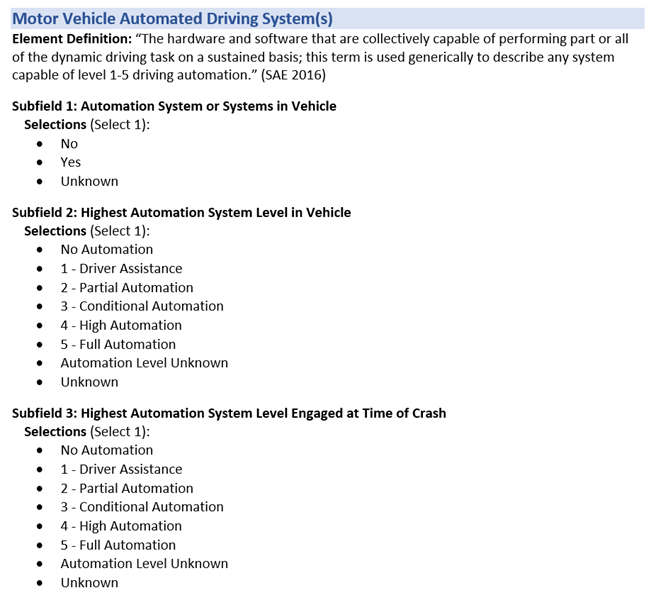
Please rate the following statements for this data element using a scale of 1-5, with 1 meaning Strongly Agree and 5 meaning Strongly Disagree.
|
1-Strongly Agree |
2-Agree |
3-Neutral |
4-Disagree |
5-Strongly Disagree |
This data element is clearly defined and understandable |
|
|
|
|
|
This data element can be collected at the scene of a crash |
|
|
|
|
|
This data element can be completed based on facts, not speculation |
|
|
|
|
|
This data element has a reasonable number of selections |
|
|
|
|
|
Reflecting on your answers above, could this data element be improved? If so, how?
Data Element Review: Condition at Time of the Crash
Review the data element and answer the following questions.
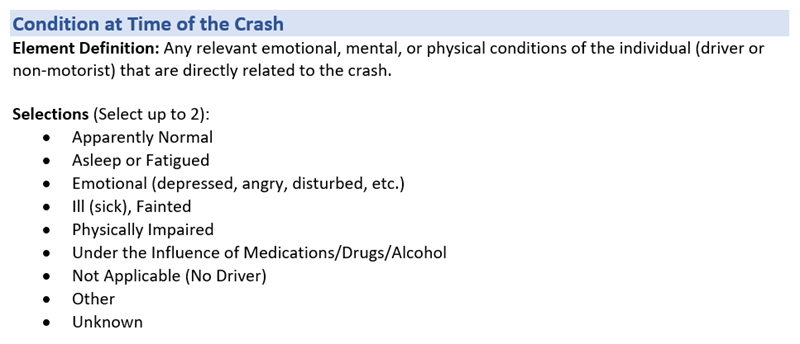
Please rate the following statements for this data element using a scale of 1-5, with 1 meaning Strongly Agree and 5 meaning Strongly Disagree.
|
1-Strongly Agree |
2-Agree |
3-Neutral |
4-Disagree |
5-Strongly Disagree |
This data element is clearly defined and understandable |
|
|
|
|
|
This data element can be collected at the scene of a crash |
|
|
|
|
|
This data element can be completed based on facts, not speculation |
|
|
|
|
|
This data element has a reasonable number of selections |
|
|
|
|
|
Reflecting on your answers above, could this data element be improved? If so, how?
Data Element Review: Restraint System Use
Review the data element and answer the following questions.
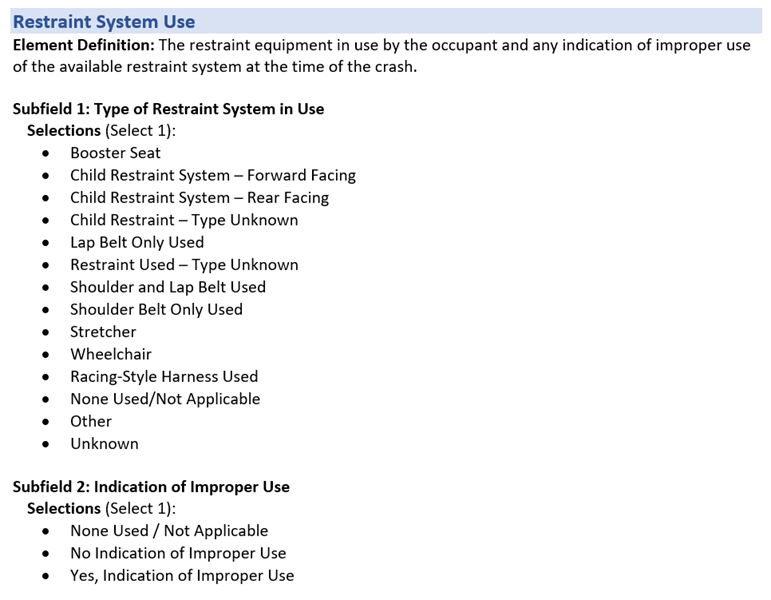
Please rate the following statements for this data element using a scale of 1-5, with 1 meaning Strongly Agree and 5 meaning Strongly Disagree.
|
1-Strongly Agree |
2-Agree |
3-Neutral |
4-Disagree |
5-Strongly Disagree |
This data element is clearly defined and understandable |
|
|
|
|
|
This data element can be collected at the scene of a crash |
|
|
|
|
|
This data element can be completed based on facts, not speculation |
|
|
|
|
|
This data element has a reasonable number of selections |
|
|
|
|
|
Reflecting on your answers above, could this data element be improved? If so, how?
Data Element Review: Underride/Override
Review the data element and answer the following questions.

Please rate the following statements for this data element using a scale of 1-5, with 1 meaning Strongly Agree and 5 meaning Strongly Disagree.
|
1-Strongly Agree |
2-Agree |
3-Neutral |
4-Disagree |
5-Strongly Disagree |
This data element is clearly defined and understandable |
|
|
|
|
|
This data element can be collected at the scene of a crash |
|
|
|
|
|
This data element can be completed based on facts, not speculation |
|
|
|
|
|
This data element has a reasonable number of selections |
|
|
|
|
|
Reflecting on your answers above, could this data element be improved? If so, how?
Experience and Background
Number of years working as a Law Enforcement Officer writing traffic crash reports
Less than 1 year
1-3 years
4-6 years
7-9 years
10 or more years
Estimated number of crash reports completed in past 12 months
20 or Less
21-40
41-60
61-80
81 or more
Select all the types of crashes for which you have completed reports
crash with property damage only (no injuries)
crash with minor injury
crash with serious injury
crash with fatal injury
crash involving released hazardous material
crash with an alcohol-impaired driver
crash with drug-impaired driver
crash involving large vehicle or bus (FMCSA reportable)
crash involving bicyclist
crash involving pedestrian
crash involving motorcycle
Select the highest level of training you have received for completing traffic crash reports
Police academy only
Additional training upon entering traffic division
On the job training/mentoring
Periodic training (less often than annual)
Annual training
Regular training (more often than annual)
Advanced training in crash investigation and/or reconstruction
NHTSA Form 1674
| File Type | application/vnd.openxmlformats-officedocument.wordprocessingml.document |
| Author | Reed, Joanna (NHTSA) |
| File Modified | 0000-00-00 |
| File Created | 2022-08-31 |
© 2025 OMB.report | Privacy Policy